Why a Pink Candle in the Advent Wreath?
Posted: December 11, 2013 Filed under: Advent | Tags: advent wreath, pink candle 3 Comments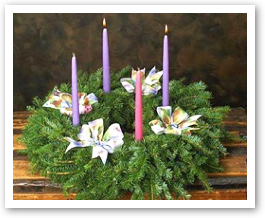 Few things get church folks more riled up than a conversation about what color candles to use in the parish Advent Wreath. All purple, all white, all blue, all red, three blue and one pink, three purple and one pink, or some other color combination. And that’s even before the discussion over whether or not to add a Christ Candle in the middle on Christmas Eve. I know one rector who was even accused of “ruining Advent” for using the “wrong” color of candles one year. Of course this is all high on Jesus’ list, I’m sure.
Few things get church folks more riled up than a conversation about what color candles to use in the parish Advent Wreath. All purple, all white, all blue, all red, three blue and one pink, three purple and one pink, or some other color combination. And that’s even before the discussion over whether or not to add a Christ Candle in the middle on Christmas Eve. I know one rector who was even accused of “ruining Advent” for using the “wrong” color of candles one year. Of course this is all high on Jesus’ list, I’m sure.
In my parish, we use three purple candles with a pink candle lit on the Third Sunday of Advent. This is the traditional practice in most, by by no means all, liturgical churches. We don’t do this for aesthetics — we’re not trying to prep out by getting our Talbots on (yes, I live in Hingham, Massachusetts, home of Talbots). Nor is it because the males among us need to demonstrate just how secure we are in our masculinity. No, that third candle is pink (or technically rose-colored) because it’s Gaudete Sunday. Huh?
Okay, let me back up and do some explaining here. First of all, we refer to the Third Sunday in Advent as Gaudete Sunday because the introit for the mass begins “Gaudete in Domino semper: iterum dico, gaudete” meaning “Rejoice in the Lord always: again I say rejoice.” While much of the penitential nature of the season has been lost in favor of hopeful expectation, some of the readings still do sound this note. The Third Sunday has traditionally been a respite from the penitential themes of Advent emphasizing instead the joy of the coming of the Lord.
 Thus many view the pink candle as emphasizing joy. As with most things liturgical, however, there is not consensus here. Some associate the candle with Mary and perhaps there’s confusion because “Mothering Sunday” — the Fourth Sunday in Lent — is the other occasion for rose-colored vestments. This is a slight misnomer, however, because Mothering Sunday refers not to Our Lady but to an old practice in England where the rich gave their servants the Sunday off to go home and visit their mothers. Indeed, Mary appears in the readings for the Fourth Sunday in Advent, not the third. And, yes, some parishes light a pink candle on the Fourth Sunday of Advent rather than the Third, further muddying the waters.
Thus many view the pink candle as emphasizing joy. As with most things liturgical, however, there is not consensus here. Some associate the candle with Mary and perhaps there’s confusion because “Mothering Sunday” — the Fourth Sunday in Lent — is the other occasion for rose-colored vestments. This is a slight misnomer, however, because Mothering Sunday refers not to Our Lady but to an old practice in England where the rich gave their servants the Sunday off to go home and visit their mothers. Indeed, Mary appears in the readings for the Fourth Sunday in Advent, not the third. And, yes, some parishes light a pink candle on the Fourth Sunday of Advent rather than the Third, further muddying the waters.
To go even further back, it’s worth looking at the history of Advent wreaths themselves. There is evidence that some pre-Christian Germanic people placed candles on wreaths in the middle of winter as a symbol of hope that the warm weather of spring would return. And ancient Scandinavians placed candles on wheels in “the bleak mid-winter” as an anticipatory devotion to the sun god. It wasn’t until the Middle Ages that Christians adopted the practice of the Advent wreath as a pre-Christmas devotion.
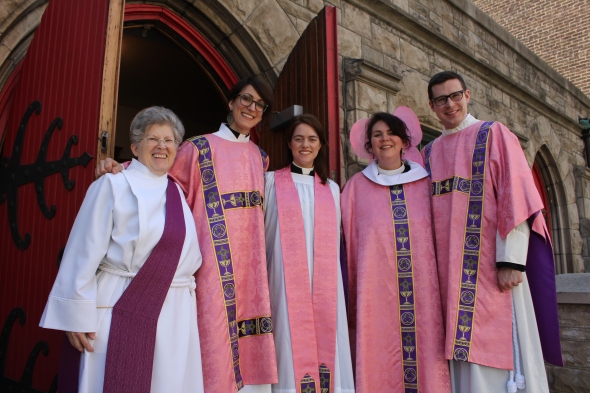 As I mentioned, some churches use rose-colored vestments twice a year — on the Fourth Sunday in Lent and the Third Sunday in Advent. Both days are seen as times of refreshment, feasting, and joy amid a penitential season. I know a priest who, back when he was a curate, always celebrated the Eucharist on these two days. It seems the parish owned a rose set and the rector declared he never, ever wanted to wear pink at the altar!
As I mentioned, some churches use rose-colored vestments twice a year — on the Fourth Sunday in Lent and the Third Sunday in Advent. Both days are seen as times of refreshment, feasting, and joy amid a penitential season. I know a priest who, back when he was a curate, always celebrated the Eucharist on these two days. It seems the parish owned a rose set and the rector declared he never, ever wanted to wear pink at the altar!
So there you have it — a brief explanation about the pink candle that will be lit this Sunday. A least in some parishes. May this season bring you the joy of Christ as we continue in hopeful anticipation.
Elf on the What?
Posted: December 3, 2013 Filed under: Advent, Christmas, Church Humor 1 Comment Unless you don’t have young kids at home or simply aren’t interested in all things Christmas, you’ve undoubtedly heard of the “Elf on the Shelf.” While my own kids now aged 14 and 12 missed the whole thing, the phenomenon has exploded the last few years. What is it? According to the website, “The Elf on the Shelf®: A Christmas Tradition is the very special tool that helps Santa know who to put on the Naughty and Nice list.”
Unless you don’t have young kids at home or simply aren’t interested in all things Christmas, you’ve undoubtedly heard of the “Elf on the Shelf.” While my own kids now aged 14 and 12 missed the whole thing, the phenomenon has exploded the last few years. What is it? According to the website, “The Elf on the Shelf®: A Christmas Tradition is the very special tool that helps Santa know who to put on the Naughty and Nice list.”
In other words, it’s a socially acceptable way to threaten and control your child’s behavior in the days leading up  to Christmas. Well, that’s the cynical view. For many it’s a fun, interactive way to build excitement in the days leading up to Christmas. The Elf moves to a different spot in the house every night — creativity is encouraged — and the kids jump out of bed to find him the next morning.
to Christmas. Well, that’s the cynical view. For many it’s a fun, interactive way to build excitement in the days leading up to Christmas. The Elf moves to a different spot in the house every night — creativity is encouraged — and the kids jump out of bed to find him the next morning.
Of course some parents have taken this to the extreme as the website Elf on the Shelf Ideas clearly demonstrates.
There’s also a site dedicated to inappropriate Elf on the Shelf poses that I cannot officially endorse called Oh You Naughty Elf. Click at your own risk.
Perhaps because I never experienced the Elf on the Shelf firsthand, I thought I’d put my lifesavings into a holier variation on the theme. Here’s what I came up with:
Lord on the Ford
The Messiah on the Stolichnaya
Jesus on the Cheeses
The Anointed One on the Hot Dog Bun
Christ on the Ice
The Lamb of God on the Firing Squad
The Good Shepherd on the Leopard
Redeemer on the Beamer
 While most of these likely won’t fly, despite my meticulously written business plan and eager investors, I’ve decided to put my efforts into Lord on the Ford. What’s a Christmas tradition that doesn’t include a little corporate sponsorship anyway? I’m convinced that Lord on the Ford, or LOTF, for you texters out there, will be the viral gift of the season.
While most of these likely won’t fly, despite my meticulously written business plan and eager investors, I’ve decided to put my efforts into Lord on the Ford. What’s a Christmas tradition that doesn’t include a little corporate sponsorship anyway? I’m convinced that Lord on the Ford, or LOTF, for you texters out there, will be the viral gift of the season.
I personally don’t want anything out of this venture beyond the satisfaction of bringing Jesus more fully into the December mix. Well, that and I’m hoping a 2014 (Christmas) red Ford Mustang will mysteriously appear in the rectory driveway (are you listening NSA and Ford Motor Corporation?!).
Regardless of your approach to Christmas, make sure not to put Jesus on the shelf this Advent. If you have young children at home, enjoy the magic and mystery — it’s gone all too quickly. Or put in a more positive light, it is transformed in new and life-giving ways.
Christian Formation’s “Dirty Little Secret”
Posted: November 25, 2013 Filed under: Advent, Churchy Stuff 11 Comments There’s nothing more disheartening than putting a tremendous amount of effort into an adult education program only to have a handful of people show up. This happens more than you’d think in parishes of all types, denominations, and sizes but no one wants to talk about it. Clergy don’t — because it looks like failure on their part. And lay people don’t — because they’d have to admit they weren’t interested enough to show up.
There’s nothing more disheartening than putting a tremendous amount of effort into an adult education program only to have a handful of people show up. This happens more than you’d think in parishes of all types, denominations, and sizes but no one wants to talk about it. Clergy don’t — because it looks like failure on their part. And lay people don’t — because they’d have to admit they weren’t interested enough to show up.
In fact, I’d call this lack of attendance at adult education programs the “dirty little secret” of Christian formation. It’s easy to rally around children’s formation events — Sunday School, Confirmation class, Vacation Bible School. We’re all passionate about “passing on the tradition,” even if we don’t have the time or the inclination to keep our own spiritual lives fresh and vibrant.
I don’t think this means the end of mature discipleship, it just calls for new methods of approaching adults who have precious little time. We can’t continue to offer the ubiquitous Wednesday evening potlucks as the only means to the adult education end. The pace and volume of life has changed and the Church must adapt to changing educational needs to continue to form disciples in Jesus’ name.
Fortunately, there are some church leaders out there trying to meet this new reality. Online Christian formation — for both adults and children — is a  new and exciting frontier, one that we’re still figuring out but one that we all need to embrace.
new and exciting frontier, one that we’re still figuring out but one that we all need to embrace.
One friend of mine is doing something about filling this void. Chris Yaw is an Episcopal parish priest and the founder of Church Next, a new online Christian learning initiative. He’s also a former Lent Madness Celebrity Blogger and Emmy Winner, but I digress. His team has an ever-expanding library of short, online courses on a variety of topics from ethics to liturgy to Scripture. Each course consists of four five-minute videos from experts across multiple denominations. An individual can subscribe or a parish can do so, in effect, creating an online “school” for the congregation. People can watch videos on their own schedule at their own pace and may or may not then engage in face-to-face conversations at church.
The key is flexibility, accessibility, and access to solid content. Check out the ever-expanding online library here.
Chris asked me to do a class on the season of Advent. I haven’t actually seen all the videos but you can watch (and share) the first one as a free sample. Here’s the course description.
I really believe this is the future of Christian formation — not replacing in-person parish formation programs but supplementing them and giving people who are too busy to attend potluck suppers access to spiritual growth. Imagine being able to grow your faith while waiting on the carpool line or with that first cup of coffee when the house is blessedly quiet or during your morning commute. It’s a concept that’s past due and one that embraces the changing landscape rather than simply ruing it.
The “Dog” has Landed
Posted: November 4, 2013 Filed under: Advent, Christmas, Writing 1 CommentWhile my own copies are “in the mail,” my new book Dog in the Manger: Finding God in Christmas Chaos is now available! Below is the press release which includes a nice quote from my archnemesis, Forward Movement Executive Director Scott Gunn. If the kind words shock you, just imagine him saying them though gritted teeth. I may or may not have said something complimentary in the Acknowledgments section — you’ll just have to buy the book to find out (and that, my friends, is what we call a “teaser”).
If for no other reason, I suggest you pick up a copy for the accompanying cartoons alone. Priest and cartoonist Jay Sidebotham is at his whimsical best, capturing the essence of each essay and conveying the inherent humor — scroll down to see a couple that appear in the book. As I’ve said before, I’m hoping people will buy the book because they think it’s one of Jay’s now famous annual church calendars. A brilliantly diabolical marketing scheme by the folks at Forward Movement!
The book makes a great, cheap ($10) last-minute Advent or Christmas gift. As I think about it, it would be perfect to give to friends and family for St. Nicholas Day on December 6th since it’s the ideal size to jam into a shoe.
Also, for clergy friends, you can use it for a fun, interactive Advent series — there are reflection questions following each section. I’m personally using it as a two-part series on Advent spirituality for parents but it’s appropriate conversation fodder for adults of any age.
Anyway, I do hope you enjoy it. It was fun to pull these essays together and it kept me off the streets during the Lent Madness offseason.
Peace,
Tim+
New Advent & Christmas Book from Forward Movement
Forward Movement is pleased to announce the publication of Dog in the Manger: Finding God in Christmas Chaos, written by the Rev. Tim Schenck and illustrated by the Rev. Jay Sidebotham.
“Our faith is a gift, but it isn’t a perfectly wrapped present with exact folds and a precisely tied bow. Fortunately faith isn’t about being neat and tidy,” writes Schenck. “You may burn the Christmas roast, Santa may not bring your child exactly what she wanted, you might even get sick and miss out on the best party of the year. But through it all, God remains.”
 With its laugh-out-loud humor anchored by spiritual truths, Dog in the Manger helps us maintain our spiritual sanity through the often-frenetic chaos of Advent and Christmas.
With its laugh-out-loud humor anchored by spiritual truths, Dog in the Manger helps us maintain our spiritual sanity through the often-frenetic chaos of Advent and Christmas.
“My heart weeps when I see people so frazzled in the weeks leading up to December twenty-fifth that it sucks the joy out of Christmas,” laments Schenck. “We all struggle to remain spiritually centered amid the frenzy of the holidays. Hopefully this book will make you laugh, nod your head in recognition, and help you keep both faith and perspective at the center of your celebration.”
Illustrated by popular cartoonist Jay Sidebotham, Dog in the Manger also explores the major characters of the season in new ways, including John the Baptist, Mary, Joseph – and of course, Jesus. Thoughtful questions following each section make Dog in the Manger ideal for personal reflection, seasonal book groups, or a last-minute Christmas gift.
 “Creating illustrations for Tim’s engaging stories was a lot of fun,” Jay Sidebotham reveals. “I know readers will savor his insights into the joys and challenges we all face in navigating the holidays. I hope that my drawings, prompted by Tim’s fine text, add to that experience, and that the book will become one more way that we prepare, faithfully, for Christmas.”
“Creating illustrations for Tim’s engaging stories was a lot of fun,” Jay Sidebotham reveals. “I know readers will savor his insights into the joys and challenges we all face in navigating the holidays. I hope that my drawings, prompted by Tim’s fine text, add to that experience, and that the book will become one more way that we prepare, faithfully, for Christmas.”
Richelle Thompson, managing editor at Forward Movement, raves, “As a reader, a mom, a wife, and occasional perfectionist, Tim’s hilarious essays help me rediscover the joy of the Christmas chaos. These reflections encourage all of us to ensure Christ is at the center of the frenzy, from getting the family photo to wrapping unwieldy gifts to the inevitable post-Christmas blues.”
“Tim deftly uses humor to show us how we can find God even when Christmas Eve doesn’t end up looking like the postcard we had in our minds.” observes The Rev. Scott Gunn, Executive Director of Forward Movement, and co-conspirator with Schenck on Lent Madness. “With laughter and wisdom in good measure, we can succeed in discovering the true joy of Christmas even in chaos.”
 The Rev. Tim Schenck is rector of the Episcopal Parish of St. John the Evangelist in Hingham, Massachusetts, and the creator of Lent Madness. He is the author of What Size Are God’s Shoes: Kids, Chaos, and the Spiritual Life (Morehouse 2008) and writes a monthly syndicated column for Gatehouse Media titled “In Good Faith.” When he’s not tending to his parish, drinking coffee, or blogging at Clergy Family Confidential, he’s likely hanging out with his family.
The Rev. Tim Schenck is rector of the Episcopal Parish of St. John the Evangelist in Hingham, Massachusetts, and the creator of Lent Madness. He is the author of What Size Are God’s Shoes: Kids, Chaos, and the Spiritual Life (Morehouse 2008) and writes a monthly syndicated column for Gatehouse Media titled “In Good Faith.” When he’s not tending to his parish, drinking coffee, or blogging at Clergy Family Confidential, he’s likely hanging out with his family.
 The Rev. Jay Sidebotham is well-known for his cartoons about church life and his animation work on the television cartoon Schoolhouse Rock! He is the director of RenewalWorks, a ministry of Forward Movement. He served for many years as rector of Church of the Holy Spirit in Lake Forest, Illinois, and has served congregations in New York City, Washington, D.C., North Carolina, and Rhode Island.
The Rev. Jay Sidebotham is well-known for his cartoons about church life and his animation work on the television cartoon Schoolhouse Rock! He is the director of RenewalWorks, a ministry of Forward Movement. He served for many years as rector of Church of the Holy Spirit in Lake Forest, Illinois, and has served congregations in New York City, Washington, D.C., North Carolina, and Rhode Island.
To order Dog in the Manger: Finding God in Christmas Chaos, click here.
Forward Movement works to nurture discipleship and encourage evangelism by providing print and digital resources to all who wish to deepen their spiritual engagement. Based in Cincinnati, OH since its inception in 1935, Forward Movement is widely known for Forward Day by Day. Forward Movement is a ministry of The Episcopal Church.
Even the Angels Weep
Posted: December 17, 2012 Filed under: Advent, Clergy Lifestyle 12 Comments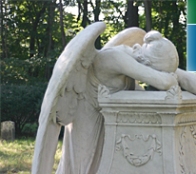 There’s a single image that keeps coming into my head in light of last week’s events at Sandy Hook Elementary School. If you walk down Main Street and head up the hill toward Old Ship Church and wrap around the bell tower into Hingham Cemetery you encounter a particularly striking gravestone. There’s a full-sized weeping angel draped over a sizable stone marker. The angel’s head is down on top of her right forearm while her left arm hangs over the edge with limp fingers pointed toward the earth. Her body language speaks of utter helplessness and defeat and the statue conveys the emotion of profound grief. A grief that transcends words; a grief that is raw and unrelenting. This has been the posture of a nation shocked by the slaughter of 20 innocent children among the dead in Newtown, Connecticut, and I can’t stop reflecting on this angel of grief. And yet even in the midst of this pain, the angel’s wings remain upright and majestic enfolding the grave marker in a gesture of embrace and a symbol of hope.
There’s a single image that keeps coming into my head in light of last week’s events at Sandy Hook Elementary School. If you walk down Main Street and head up the hill toward Old Ship Church and wrap around the bell tower into Hingham Cemetery you encounter a particularly striking gravestone. There’s a full-sized weeping angel draped over a sizable stone marker. The angel’s head is down on top of her right forearm while her left arm hangs over the edge with limp fingers pointed toward the earth. Her body language speaks of utter helplessness and defeat and the statue conveys the emotion of profound grief. A grief that transcends words; a grief that is raw and unrelenting. This has been the posture of a nation shocked by the slaughter of 20 innocent children among the dead in Newtown, Connecticut, and I can’t stop reflecting on this angel of grief. And yet even in the midst of this pain, the angel’s wings remain upright and majestic enfolding the grave marker in a gesture of embrace and a symbol of hope.
I walk up to the cemetery sometimes and just stand in front of that angel. I think about people that I have known and lost over the years. I think about the many people I have buried in my own priestly ministry — their stories, their struggles, their families, their faith. I think about the senseless killings that pervade our world through mass murder and war and acts of terror. I think about the presence of evil in our world and about the demons that drive people to desperation. And I think about the God of all hope who weeps when we weep and rejoices when we rejoice and is present to all who call upon his name.
Faith in the God whose peace surpasses all human understanding doesn’t ease the immediacy of grief. Yet there’s something about a statue so delicately carved into so solid a material. Perhaps it’s a metaphor for the fragility of human life built upon the rock of our salvation. As Christians, we place our faith upon the cornerstone that is Jesus Christ even in the midst of our own questions and doubts and weaknesses.
It’s true that human tragedy strips away the non-essentials of life and brings us right back to the things that matter most — love, faith, compassion, and companions along the journey with whom we share these things. It’s also a reminder, in these days leading up to Christmas, that this season isn’t just about a cute yet helpless baby cooing in a stable but about our very salvation. It reminds us that Christmas isn’t just about the trimmings and trappings but about the miracle of God entering the world in human form; a world that can feel so full of darkness.
Finally, it reminds us that for all of the white lights in all of the windows along Main Street, for all the fresh garland adorning white picket fences, for all the beautifully trimmed trees in homes visible from the street, there are people hurting out there. There are people who go without this season; there are people for whom the holidays bring more emotional pain than cheer; there are people living with deep anxiety; there are people who are in the throes of profound grief in a small Connecticut town. Our faith calls this dissonance out into the light and bids us to act on behalf of the poor and downtrodden, the emotionally fragile and the sick, and those who weep and mourn.
In these waning days before Christmas, I can’t help but think about the gifts that have already been wrapped and lovingly placed underneath the tree; wrapping paper that will never be torn apart; squeals of glee that will never ring out; hugs of love and gratitude that will never be felt. Yet amid this season, amid the darkness that sometimes pierces our world, Christians still point to the light of salvation that burns in our hearts and illuminates the world with peace, hope, and salvation even in the midst of despair.
Christmas is a Ticking Time Bomb
Posted: December 10, 2012 Filed under: Advent 8 Comments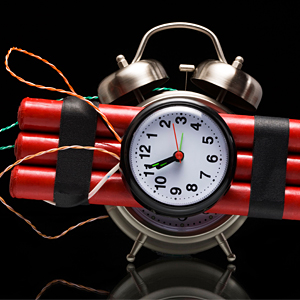 Do you hear that? It’s the ticking time bomb set to explode on December 25th. The one that will detonate whether or not the Christmas shopping gets done, the Christmas cards are sent out on time, or the vanilla meringues sag. The one that’s turned the most wonderful time of year into a race against time and replaced holy anticipation with high anxiety.
Do you hear that? It’s the ticking time bomb set to explode on December 25th. The one that will detonate whether or not the Christmas shopping gets done, the Christmas cards are sent out on time, or the vanilla meringues sag. The one that’s turned the most wonderful time of year into a race against time and replaced holy anticipation with high anxiety.
Most of society treats this time of year like an hourglass — not the slow soap opera version “Like sands through the hourglass, so are the days of our lives” — but the small one you set before a round of Boggle that leaves you frantically scrambling to find words before time runs out. The sand of our seasonal hourglass drips out all too rapidly, reminding us of the time slipping away; precious time we need not for spending time with one another and enjoying this holy season but for all that we need to get done. Christmas becomes yet another deadline in our deadline-driven lives rather than a joyful moment of expectation and hope.
It used to be that our Advent calendars and wreaths heightened the anticipation leading to the fulfillment of Incarnational joy. Now the opening of doors and the building of light cause hearts to race rather than revel. These time-honored traditions bring more stress than joy. Not to mention guilt for eating chocolate every morning.
We’ve done this to ourselves, of course. We’ve lit the fuse and literally bought into the consumerism that drives this season at the expense of our faith. The good news is that there is still hope for us. We can recapture Christmas and savor it as a time of comfort and joy rather than anxiety and stress. It takes a reorientation of our spiritual compass but with some help we’ll find that star to guide us toward the manger in way that causes our souls to sing with joy rather than shrink with disquietude.
In Biblical times when people sought to repent and return to the Lord they looked toward prophets. The prophetic message was only effective when a community 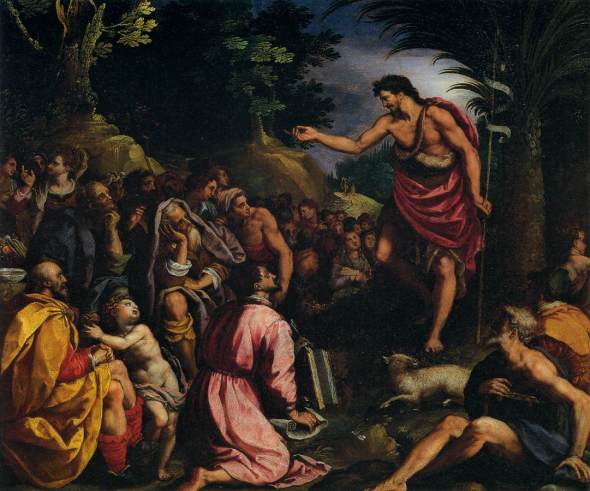 recognized the need for transformation but I think we can agree that the way we approach Christmas has gotten away from us. Fortunately Advent is dominated by a prophet who calls us back to the basics. You won’t find an eight-foot-tall inflatable John the Baptist on your neighbor’s front lawn but he looms over Advent like no other figure. John, the forerunner of the Messiah, the one who prepares us for the arrival of the Christ child boldly and loudly proclaims a baptism of repentance for the forgiveness of sins. During Advent he cuts a path through the shiny external trappings of the season while calling us to focus on the interior essentials of our faith.
recognized the need for transformation but I think we can agree that the way we approach Christmas has gotten away from us. Fortunately Advent is dominated by a prophet who calls us back to the basics. You won’t find an eight-foot-tall inflatable John the Baptist on your neighbor’s front lawn but he looms over Advent like no other figure. John, the forerunner of the Messiah, the one who prepares us for the arrival of the Christ child boldly and loudly proclaims a baptism of repentance for the forgiveness of sins. During Advent he cuts a path through the shiny external trappings of the season while calling us to focus on the interior essentials of our faith.
The Baptist reminds us this isn’t about a so-called war on Christmas; it’s about a war for Christmas. He’s passionate about the arrival of Jesus because God entering the world in human form is the bedrock of our faith. The Incarnation matters because without it, our faith is merely a house of Christmas cards, capable of being knocked down by Jack Frost’s gentlest breath. But with it, the world is transformed into a place where Resurrection glory reigns supreme and we live into our full potential as children of God.
So simply being aware of our need to recapture Christmas is an important first step. It’s an acknowledgment that, to quote the Grinch, “Maybe Christmas doesn’t come from a store. Maybe Christmas, perhaps, means a little bit more.” It’s about recapturing the delight and joy of spending time with one another while welcoming Jesus anew into our hearts and minds and souls. This time of year shouldn’t and needn’t be about obligatory presents and strategizing over re-gifting scented candles. I’m not saying shopping is evil or that we shouldn’t put up Christmas decorations. Hardly. But I am saying it’s so important to have a foot in both worlds; to take time to reflect upon why we’re doing all of this; to think about the meaning behind the madness. Otherwise we’re simply feeding the Christmas-Industrial Complex and missing the larger message of hope and salvation.
In Good Faith: Season Creep — The Lost Art of Waiting
Posted: December 7, 2012 Filed under: Advent, In Good Faith column 1 Comment My latest monthly column explores the reasons we can’t seem to enjoy one holiday without jumping ahead to the next one. I call this “Season Creep” and it’s both insidious and harmful to the soul.
My latest monthly column explores the reasons we can’t seem to enjoy one holiday without jumping ahead to the next one. I call this “Season Creep” and it’s both insidious and harmful to the soul.
Season Creep — The Lost Art of Waiting
By the Rev. Tim Schenck
Season Creep. It’s what happens when Halloween candy is put out with Back-to-School sales and Christmas decorations are up before Thanksgiving and Valentine’s Day chocolates are juxtaposed with New Year’s noisemakers. People have been bemoaning this for years even as we keep feeding into it. “I can’t believe they’re having a Christmas sale in the middle of November!” we proclaim with righteous indignation as we slap down our credit card to get a great deal on an xBox.
It’s easy to complain about the madness of it all; to reminisce about the days of yore when we actually enjoyed one season before moving on to the next. It’s harder to do something about it. It’s harder to change our lifestyle to reflect a healthier and ultimately more fulfilling approach to the changing of the seasons.
But first it’s helpful to think about why we’re in such a hurry. Why are we so ready to drop one holiday for the next even while the first holiday is still going on? Why do we have to plot out our Christmas shopping strategy while still eating pumpkin pie on Thanksgiving Day? Why can’t we be more attentive to living in the moment and enjoying the present before jumping to the next big thing? As easy as it is to foist blame on the nameless, faceless “culture of materialism,” I think it transcends consumerism and marketing.
We also have to take some responsibility here. Because when you strip away our handheld technologies and the instant access to information to which we’ve become accustomed, we’re still simply human beings seeking to make sense of our transitory lives. We rush around like mall Santas with our heads cut off because we don’t truly believe that God is present in every moment. We act as if we can just stay ahead of the pack our deep insecurities and fears will never catch up to us. Of course that’s merely setting our lives up like a house of (Christmas) cards — it’s not sustainable in the long run.
One thing that’s also lost in all of this rushing ahead is the sense of sweet anticipation. We’re not so good at living into the practice of waiting. Like your average toddler we want what we want and we want it now! Our tantrums are less public than the one thrown on the floor of the the home goods department at Macy’s but the attitude is similar.
Think about the first time you were in love. The ache of parting and then waiting until the next time you were together made your time together that much sweeter. That’s what waiting does for the soul. It makes each moment more precious and allows us to enjoy time spent together without racing to clean up the dishes or put up the Christmas tree or box up the ornaments.
This year, I encourage you to live into the season of Advent — the four weeks that precede Christmas Day. Advent is the Church’s time of holy waiting and, yes, it is extremely counter-cultural. We don’t belt out Christmas carols at church until Christmas Eve; we don’t hang the greens and put out the poinsettias around the altar until much later in the season.
(Actually I no longer refer to decorating the church at Christmas as the “hanging of the greens.” I used to, until we had a family join the church named “Green.” So now we call it the “greening of the church” and the Greens don’t have to watch their backs this time of year).
Advent is a reminder that there’s a sacred rhythm that runs parallel to the secular timetable of the season. Go ahead and shop and hum Christmas carols and watch Frosty the Snowman with the kids but be mindful of season creep. And know that only when you allow that anticipation to build as you wait and watch and prepare to meet Jesus anew, is the deep joy of Christmas complete.
How to Market Advent Lessons & Carols
Posted: December 6, 2012 Filed under: Advent, Church Humor 7 Comments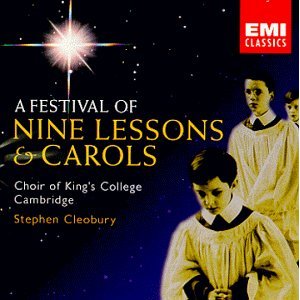 For many people it’s just not Advent until they attend a service of Lessons & Carols. This beloved liturgy has deep roots in the Anglican musical tradition and evokes images of vested choirs, coped clergy, Advent wreaths, and a December chill in the air.
For many people it’s just not Advent until they attend a service of Lessons & Carols. This beloved liturgy has deep roots in the Anglican musical tradition and evokes images of vested choirs, coped clergy, Advent wreaths, and a December chill in the air.
The service itself is structured on a liturgy first offered at the Chapel of King’s College, Cambridge, England, in 1918. Almost immediately other churches adapted the service for their own use but its popularity really began to grow when the service was first broadcast in 1928. With the exception of 1930, Advent Lessons & Carols has been broadcast annually from King’s College, even during the Second World War.
Here at St. John’s, along with many other parishes, Advent L & C ranks as one of 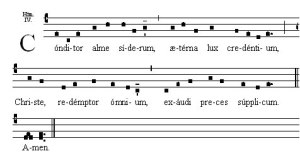 the liturgical highlights of the entire year. Now if you’re trying to draw people to your own sublimely beautiful and well-planned Advent Festival of Lessons & Carols, I have some tips. Truth be told my globe-trotting archnemesis also contributed to this list but he’s somewhere in Jerusalem at a coffee shop while I’m stuck here with visions of Christmas Eve bulletins dancing in my head so I’ll take all the credit.
the liturgical highlights of the entire year. Now if you’re trying to draw people to your own sublimely beautiful and well-planned Advent Festival of Lessons & Carols, I have some tips. Truth be told my globe-trotting archnemesis also contributed to this list but he’s somewhere in Jerusalem at a coffee shop while I’m stuck here with visions of Christmas Eve bulletins dancing in my head so I’ll take all the credit.
How to Market Advent Lessons and Carols
1. We steadfastly refuse to admit any holiday festivity so kindly leave the Christmas sweater and reindeer brooch at home. The ushers will remove any Santa hats they spot with an air of righteous indignation.
2. You’ll get to sing/mumble your way through unfamiliar Advent hymns and listen to Advent carols no one recognizes.
3. Yes, there are scary prophetic readings but they’re always undercut with a tuneful anthem (that you won’t recognize) following each one.
4. Prior to the service be sure to Google “why is there a pink candle in the advent wreath.”
5. Listen to Americans and Brits fight over the pronunciation of Isaiah (eye-ZAY-uh vs. eye-ZEYE-uh).
6. Fire hazards abound. Fortunately the liturgy is about as interesting as watching wax drip.
7. This is the one time during the year we let that crazy lady with the British accent read a lesson.
8. It’s fun to play spot the fake garland. It’s like Where’s Waldo only easier.
9. Keep waiting for someone to read Ezekiel’s passage about the Valley of Dry Bones until you remember that happens at the Easter Vigil not Lessons and Carols.
10. Judge the abilities of the various lectors and hold a grudge against the rector for not utilizing your superior reading abilities.
11. Take bets during the car ride to church over whether the parish secretary remembered to change the date on the bulletin from last year.
12. No sermon. Though most clergy make up for this by adding in a non-rubrical “announcements” section in order to “preach” about their upcoming schedule of Christmas services.
13. The reception following the liturgy is stale crackers and cheap wine. It’s a meeting point between Lent (no refreshments) and Christmas (festive food).
14. Clergy who attend will come to blows arguing over whether or not the vestments and hangings are the “correct” Advent color.
15. Episcopalians who like to ignore Marian devotion can scowl through hymns about our Blessed Mother.
I guarantee that if you take out a full page ad in the local paper listing these reasons to attend your service of Lessons and Carols, you’ll need to hire some crowd control thugs off of Craig’s List.
In the meantime, I bid you blessings during this holy season of waiting and watching and preparing for the arrival of the Christ child. Scott Gunn may or may not do likewise at his second coming (back to America) when he returns to judge the liturgy.
Believe?
Posted: December 21, 2011 Filed under: Advent, Christmas 3 Comments “Believe.” That’s Macy’s one-word advertising campaign this holiday season. You’ve likely seen it plastered on buses and screaming across the top of full page newspaper ads. I’ve found it jarring because it feels either like a subliminal Cold War-era message or an emasculation of the word itself.
“Believe.” That’s Macy’s one-word advertising campaign this holiday season. You’ve likely seen it plastered on buses and screaming across the top of full page newspaper ads. I’ve found it jarring because it feels either like a subliminal Cold War-era message or an emasculation of the word itself.
Yes, I know that Macy’s has a whole charitable giving program based on the campaign that benefits the Make-a-Wish Foundation. And that’s a good thing even if it’s an add-on to deflect any potential criticism from, ahem, the blogging public.
The whole notion of what to believe is left intentionally ambiguous. This month, the choices are wide open: Santa, Christ, general hearth and home goodness, the Christmas-Industrial Complex, yourself, that your credit card debt will magically disappear. It’s a clever ad campaign meant to encourage good feelings and prime the economic pump.
But as a Christian who celebrates the coming of the Christ child this month (yes, some of us still do) it grates. Maybe it’s because Christmas is not about belief in general but belief in particular.
 The word itself derives from the Latin credo — from whence we derive the word creed. On Christmas Eve those who make it to church will recite the Nicene Creed, the primary Christian statement of faith. It begins “I believe in one God” or Credo in unum Deum in Latin. And we’ll go on to proclaim our belief in the Incarnation of Jesus by saying, “For us and our salvation he came down from heaven: by the power of the Holy Spirit he became incarnate of the Virgin Mary, and was made man.”
The word itself derives from the Latin credo — from whence we derive the word creed. On Christmas Eve those who make it to church will recite the Nicene Creed, the primary Christian statement of faith. It begins “I believe in one God” or Credo in unum Deum in Latin. And we’ll go on to proclaim our belief in the Incarnation of Jesus by saying, “For us and our salvation he came down from heaven: by the power of the Holy Spirit he became incarnate of the Virgin Mary, and was made man.”
That’s the belief that I’m focused on this time of year — the belief that ultimately defines Christmas itself.
So, thank you Macy’s for encouraging us to “believe.” But we’ll take it from here.
The O Antiphons — Decoded
Posted: December 20, 2011 Filed under: Advent Leave a comment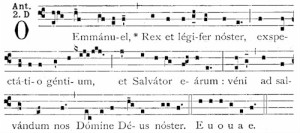 First, let me be clear: they have nothing to do with Oprah. Nor are they related to other songs beginning with “O” like O Susanna, O Christmas Tree, O Little Town of Bethlehem, or O-bla-di-O-bla-da.
First, let me be clear: they have nothing to do with Oprah. Nor are they related to other songs beginning with “O” like O Susanna, O Christmas Tree, O Little Town of Bethlehem, or O-bla-di-O-bla-da.
The “O Antiphons” are a traditional Advent devotion dating to as early as the 5th century. Benedictine monasteries provide some of the earliest evidence of their usage and by the 8th century they were commonly used in Roman churches. There are seven “O’s” (the name simply derives from the start of each antiphon — “O Sapienta, O Adonai, etc.). Thus the first is recited on December 17th and the last on December 23rd.
Each antiphon is based on a title used for Jesus in Scripture thus (and I realize I’ve used the word “thus” in consecutive sentences):
- December 17: O Sapientia (O Wisdom)
- December 18: O Adonai (O Lord)
- December 19: O Radix Jesse (O Root of Jesse)
- December 20: O Clavis David (O Key of David)
- December 21: O Oriens (O Dayspring)
- December 22: O Rex Gentium (O King of the Nations)
- December 23: O Emmanuel (O God-With-Us)
 If the English words sound familiar, you’re no doubt acquainted with the classic Advent hymn “O Come, O Come Emmanuel” which is based on these antiphons.
If the English words sound familiar, you’re no doubt acquainted with the classic Advent hymn “O Come, O Come Emmanuel” which is based on these antiphons.
In Anglican usage the O Antiphons are traditionally used before and after the Magnificat at Evening Prayer (sung at Evensong) or as the Alleluia verse before the gospel reading during the appointed days. For many, they are used as private devotions during the waning days of Advent.
Click here to access a full list of the O Antiphons (along with their Scriptural citations) in both Latin and English. This comes from the Liturgy blog of the wonderful New Zealander Bosco Peters. Enjoy.



